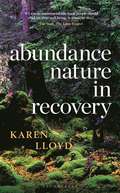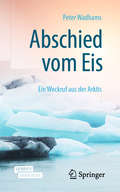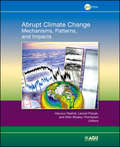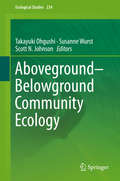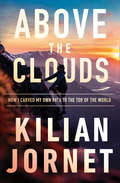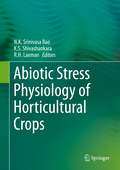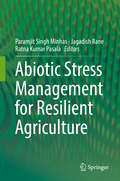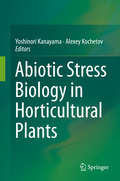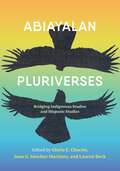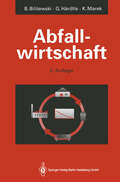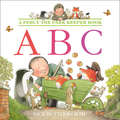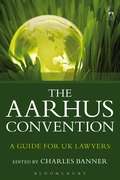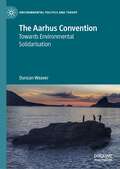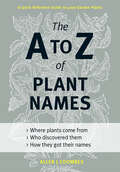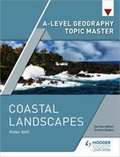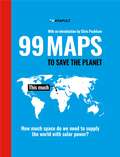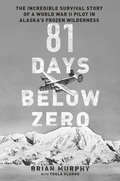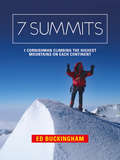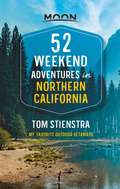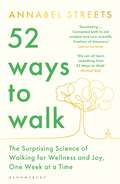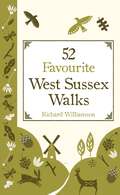- Table View
- List View
Abundance: Nature in Recovery
by Karen LloydIn this collection of literary essays, Karen Lloyd explores abundance and loss in the natural world, relating compelling stories of restoration, renewal and repair, describing how those working on the front lines of conservation are challenging the inevitability of biodiversity loss, as well as navigating her own explorations of the meaning of abundance in the Anthropocene. In an era of urgent ecological challenge, her timely book reveals the places that people are coming together to bring species and habitats back from the edge of extinction. Yet, elsewhere, many other species are being allowed to disappear forever. To understand why, she examines how humans have chosen to entangle themselves in nature and considers the ways we perceive the natural world. A book about ways of seeing, as Lloyd explores attitudes towards meaningful restoration, she weaves her insightful and joyous narrative through a diverse range of inspiring landscapes, from Romania's Carpathian mountains and the Hungarian Steppe to Perthshire's rivers and the dune forests of the Netherlands.
Abschied vom Eis: Ein Weckruf aus der Arktis
by Peter WadhamsDas Meereis der Polargebiete ist nicht nur wunderschön, es reguliert auch die Temperatur der Erde. Doch es zieht sich zurück – und zwar schnell! Dabei laufen komplexe Rückkopplungen ab, die das Potenzial haben, den Klimawandel zu beschleunigen und zu verstärken. Der britische Polarforscher Peter Wadhams ist einer der international führenden Meereisexperten. Er greift auf seine fast lebenslange Forschung in der Arktis zurück, um zu erklären, was gerade passiert, was das für unsere Zukunft bedeutet – und was wir tun können und müssen.Der AutorPeter Wadhams ist einer der weltweit erfahrensten Polar- und Meereisforscher. Er war von 1987–92 Direktor des Scott Polar Institute in Cambridge und dort auch von 1992–2015 Professor für Physik der Ozeane. Er war an mehr als 50 Expeditionen in beide Polarregionen beteiligt – in Forschungscamps, auf Eisbrechern, von Flugzeugen aus, und sogar in Unterseebooten. Er wurde ausgezeichnet mit dem W. S. Bruce-Preis der Royal Society of Edinburgh (1977), der UK Polar Medal (1987) und dem Italgas-Preis für Umweltwissenschaften (1990). Er ist Fellow der Royal Geographical Society und Mitglied der Finnischen Akademie.
Abrupt Climate Change: Mechanisms, Patterns, and Impacts (Geophysical Monograph Series #193)
by Harunur Rashid Leonid Polyak Ellen Mosley-ThompsonPublished by the American Geophysical Union as part of the Geophysical Monograph Series, Volume 193.Abrupt Climate Change: Mechanisms, Patterns, and Impacts brings together a diverse group of paleoproxy records such as ice cores, marine sediments, terrestrial (lakes and speleothems) archives, and coupled ocean-atmosphere climate models to document recent advances in understanding the mechanisms of abrupt climate changes. Since the discovery of the Dansgaard-Oeschger events in Greenland ice cores and the subsequent discovery of their contemporary events in the marine sediments of the North Atlantic, the search for these abrupt, millennial-scale events across the globe has intensified, and as a result, the number of paleoclimatic records chronicling such events has increased. The volume highlights include discussions of records of past climate variability, meridional overturning circulation, land-ocean-atmosphere interactions, feedbacks in the climate system, and global temperature anomalies. Abrupt Climate Change will be of interest to students, researchers, academics, and policy makers who are concerned about abrupt climate change and its potential impact on society.
Abrupt Climate Change: Mechanisms, Patterns, and Impacts (Geophysical Monograph Series #193)
by Harunur Rashid Leonid Polyak Ellen Mosley-ThompsonPublished by the American Geophysical Union as part of the Geophysical Monograph Series, Volume 193.Abrupt Climate Change: Mechanisms, Patterns, and Impacts brings together a diverse group of paleoproxy records such as ice cores, marine sediments, terrestrial (lakes and speleothems) archives, and coupled ocean-atmosphere climate models to document recent advances in understanding the mechanisms of abrupt climate changes. Since the discovery of the Dansgaard-Oeschger events in Greenland ice cores and the subsequent discovery of their contemporary events in the marine sediments of the North Atlantic, the search for these abrupt, millennial-scale events across the globe has intensified, and as a result, the number of paleoclimatic records chronicling such events has increased. The volume highlights include discussions of records of past climate variability, meridional overturning circulation, land-ocean-atmosphere interactions, feedbacks in the climate system, and global temperature anomalies. Abrupt Climate Change will be of interest to students, researchers, academics, and policy makers who are concerned about abrupt climate change and its potential impact on society.
Aboveground–Belowground Community Ecology (Ecological Studies #234)
by Takayuki Ohgushi Susanne Wurst Scott N. JohnsonResearchers now recognize that above- and belowground communities are indirectly linked to one another, often by plant-mediated mechanisms. To date, however, there has been no single multi-authored edited volume on the subject. This book remedies that gap, and offers state-of-the art insights into basic and applied research on aboveground-belowground interactions and their functional consequences. Drawing on a diverse pool of global expertise, the authors present diverse approaches that span a range of scales and levels of complexity.The respective chapters provide in-depth information on the current state of research, and outline future prospects in the field of aboveground-belowground community ecology. In particular, the book’s goal is to expand readers’ knowledge of the evolutionary, community and ecosystem consequences of aboveground-belowground interactions, making it essential reading for all biologists, graduate students and advanced undergraduates working in this rapidly expanding field. It touches on multiple research fields including ecology, botany, zoology, entomology, microbiology and the related applied areas of biodiversity management and conservation.
Above the Clouds: The Nature Of Mountains, The Terrain Of An Athlete And How I Carved My Own Path To The Top Of The World
by Kilian JornetThe most accomplished mountain runner of all time contemplates his record-breaking climb of Mount Everest in this profound and free-flowing memoir—an intellectual and spiritual journey that moves from the earth’s highest peak to the soul’s deepest reaches.
Abiotic Stress Physiology of Horticultural Crops
by N.K. Srinivasa Rao K. S. Shivashankara R. H. LaxmanThis book brings together recent advances in the area of abiotic stress tolerance in various vegetables, fruit crops, plantation crops and tuber crops. The main challenges to improving the productivity of horticultural crops are the different types of abiotic stresses generally caused by climate change at the regional and global level. Heat, drought, cold and salinity are the major abiotic stresses that adversely affect growth and productivity and can trigger a series of morphological, physiological, biochemical and molecular changes in various horticultural crops. To date, there are no books covering horticultural crop-specific abiotic stress tolerance mechanisms and their management. Addressing that gap, the book is divided into 2 sections, the first of which highlights recent advances in the general aspects of abiotic stress tolerance like the role of hormones, reactive oxygen species, seed treatments, molecular mechanisms of heat tolerance and heavy metal toxicity, while the second focuses on the abiotic stress tolerance mechanisms of various vegetables, fruit crops, plantation crops and tuber crops. It includes comprehensive discussions of fruit crops like mango, grapes, banana, litchi and arid zone fruits; vegetables crops like tomato, capsicum, onion and tuber crops; and plantation crops like coconut, areca nut, oil palm and black pepper. Among the strategies for plant stress survival, examples of both avoidance and tolerance relevant to particular crops are examined in detail, supported by selected comprehensive case studies of progress. As such, the book offers a valuable resource suited for scientists and graduate students working in the fields of crop improvement, genetic engineering, and the abiotic stress tolerance of horticultural crops.
Abiotic Stress Management for Resilient Agriculture
by Paramjit Singh Minhas Jagadish Rane Ratna Kumar PasalaThis book offers a state-of-the-art overview of on abiotic stresses in terms of the challenges; scope and opportunities; copping strategies for adaptation and mitigation using novel tools for building resilience in agricultural crops and livestock; as well as for policy implementation. Divided into four major parts: advances and prospects for understanding stress environments; adaptation and mitigation options; crop-based mitigation strategies; and mitigation options in animal husbandry, the book focuses on problem-solving approaches and techniques that are essential for the medium to long-term sustainability of agricultural production systems The synthesis and integration of knowledge and experiences of specialists from different disciplines offers new perspectives in the versatile field of abiotic stress management, and as such is useful for various stakeholders, including agricultural students, scientists, environmentalists, policymakers, and social scientists.
Abiotic Stress Biology in Horticultural Plants
by Yoshinori Kanayama Alexey KochetovThe purpose of this publication is to elucidate the biological aspect of the abiotic stress response from the field to the molecular level in horticultural plants. This book is unique in that it concerns the basic aspect of abiotic stress biology and research progress at the molecular level in model plants or major field crops, as it focuses mainly on the abiotic stress response in existing horticultural plants. Many readers interested in plant abiotic stress biology are aware of the application of the latest findings to agricultural production, and this book will have a special appeal for those readers. The book will be of interest to scientists and graduate students who are involved in the research, development, production, processing, and marketing of horticultural products, including those in developing countries who are interested in high tech and advanced science in this field. The application of the latest findings to agricultural production is particularly useful.Stress tolerance mechanisms in horticultural crops are gaining importance, because most agricultural regions are predicted to experience considerably more extreme environmental fluctuations due to global climate change. Further, because of recent progress in next-generation sequencing technologies, the postgenomic era is impending not only in model plants and major cereal crops but also in horticultural crops, which comprise a great diversity of species. This book provides information on the physiological aspects of the abiotic stress response in horticultural plants, which is considered essential for postgenomic research.
Abiayalan Pluriverses: Bridging Indigenous Studies and Hispanic Studies
by Gloria ChacónAbiayalan Pluriverses: Bridging Indigenous Studies and Hispanic Studies looks for pathways that better connect two often siloed disciplines. This edited collection brings together different disciplinary experiences and perspectives to this objective, weaving together researchers, artists, instructors, and authors who have found ways of bridging Indigenous and Hispanic studies through trans-Indigenous reading methods, intercultural dialogues, and reflections on translation and epistemology. Each chapter brings rich context that bears on some aspect of the Indigenous Americas and its crossroads with Hispanic studies, from Canada to Chile. Such a hemispheric and interdisciplinary approach offers innovative and significant means of challenging the coloniality of Hispanic studies.
Abfallwirtschaft: Eine Einführung
by Bernd Bilitewski Georg Härdtle Klaus MarekDas vollständige deutschsprachige Werk zum Thema Abfall, das alle Fragen der Umweltbeauftragten auf kommunaler Ebene beantwortet. Gleichzeitig eignet sich das Buch hervorragend als Lehrbuch für Fachhochschulen und Universitäten. In der zweiten Auflage wurden auch abgesicherte Erfahrungen aus den neuen Bundesländern ausgewertet. Vor allem die Diskussion um das Duale System wird mit diesem Werk auf eine solide Basis gestellt.
ABC (Percy the Park Keeper)
by Nick ButterworthLearn to the letters of the alphabet with Percy the park keeper and his animal friends in this fun first concept book from highly regarded, award-winning author/illustrator Nick Butterworth.
The Aarhus Convention: A Guide for UK Lawyers
by Charles BannerThe UNECE Convention on Access to Information, Public Participation in Decision-Making and Access to Justice in Environmental Matters – known ubiquitously as the Aarhus Convention – is having an ever-increasing influence on domestic and EU environmental law and procedure. Recent years have seen a steady flow of case law from the UK courts, the Court of Justice of the European Union (CJEU) and the Aarhus Convention Compliance Committee, a raft of civil procedure reforms in response to concerns about whether the costs rules in domestic environmental litigation are compatible with the Convention and an infraction by the European Commission against the UK alleging various systemic breaches. Even the EU itself has been the subject of a ruling by the Compliance Committee that the CJEU's rules on standing for judicial review of EU legislation are too narrow to comply with the Convention. This book, written by several of the leading experts in the field, provides a comprehensive guide to the implementation of the Convention in each of the UK's jurisdictions, the three pillars of the Convention (access to information, public participation and access to justice) and the mechanisms by which the rights under the Convention can be enforced.
The Aarhus Convention: A Guide for UK Lawyers
by Charles BannerThe UNECE Convention on Access to Information, Public Participation in Decision-Making and Access to Justice in Environmental Matters – known ubiquitously as the Aarhus Convention – is having an ever-increasing influence on domestic and EU environmental law and procedure. Recent years have seen a steady flow of case law from the UK courts, the Court of Justice of the European Union (CJEU) and the Aarhus Convention Compliance Committee, a raft of civil procedure reforms in response to concerns about whether the costs rules in domestic environmental litigation are compatible with the Convention and an infraction by the European Commission against the UK alleging various systemic breaches. Even the EU itself has been the subject of a ruling by the Compliance Committee that the CJEU's rules on standing for judicial review of EU legislation are too narrow to comply with the Convention. This book, written by several of the leading experts in the field, provides a comprehensive guide to the implementation of the Convention in each of the UK's jurisdictions, the three pillars of the Convention (access to information, public participation and access to justice) and the mechanisms by which the rights under the Convention can be enforced.
The Aarhus Convention: Towards Environmental Solidarisation (Environmental Politics and Theory)
by Duncan WeaverThe Aarhus Convention on access to information, public participation in decision-making and access to justice in environmental matters has been celebrated as a pioneering international environmental agreement. Given that a quarter-century has passed since Aarhus was opened for signature, now is an opportune moment to revisit it from a fresh perspective. Marking this anniversary, this book explores Aarhus from the vista of the English School of International Relations, an ethically-minded perspective used to gauge the prevalence of state-oriented and human-oriented progress from the Convention's rationales and realities. It firstly considers Aarhus' propagation, investigating the legal, diplomatic and geopolitical contexts enabling its emergence. It secondly investigates Aarhus' germination, with reference to its trinity of procedural rights. Thirdly, the book examines the Convention's growth, in terms of the development of its organisational infrastructure. The chief finding is that Aarhus demonstrates, in environmental contexts, the feasibility and benefit of fostering 'humankind' solidarist progress, rooted in moral cosmopolitanism, within the existing power arrangements of a sovereignty-based pluralism. Pluralist concerns for diversity and international order are found to be a precondition for more ethically ambitious solidarist endeavours. These observations reinforce the logic of solidarisation, an English School innovation that presents sovereignty as (a) being ethically matured by solidarism whilst (b) delimiting solidarism within the threshold of states' tolerance.
The A to Z of Plant Names: A Quick Reference Guide to 4000 Garden Plants
by Allen J. CoombesBotanical names can be baffling to even the most experienced gardener. But a plant's botanical name is more than just a handy label—it can tell a plant's country of origin, the shape of its leaves, the color of its petals, and much more. The A to Z of Plant Names clears the confusion and allows every gardener to name plants with confidence. This comprehensive yet handy guide features the botanic names of the plants that gardeners really grow. Additional information includes suggested pronunciation, the common name, the derivation of the scientific name, the number of species currently accepted, the type of plant and the distribution. The A to Z of Plant Names helps demystify names, provides readers with the intriguing background information to naming conventions, and empowers gardeners everywhere to feel confident about naming plants.
A-level Geography Topic Master: Coastal Landscapes (PDF)
by Peter StiffExam board: AQA, Edexcel, OCR, WJEC/Eduqas Level: A-level Subject: Geography First teaching: September 2016 First exams: Summer 2017 (AS); Summer 2018 (A-level) Master the in-depth knowledge and higher-level skills that A-level Geography students need to succeed; this focused topic book extends learning far beyond your course textbooks.
99 Maps to Save the Planet: With an introduction by Chris Packham
by KATAPULT'Terrifying yet funny, surprising yet predictable, simple yet poignant' Chris PackhamA shocking but informative, eye-catching and witty book of maps that illustrate the perilous state of our planet.The maps in this book are often shocking, sometimes amusing, and packed with essential information:· Did you know that just 67 companies worldwide are responsible for 67 per cent of global greenhouse emissions? · Or that keeping a horse has the same carbon footprint as a 23,500-kilometre road trip? · Did you know how many countries use less energy than is consumed globally by downloading porn from the internet?· Do you know how much of the earth's surface has been concreted over?· Or how many trees would we have to plant to make our planet carbon-neutral?Presenting a wealth of innovative scientific research and data in stunning, beautiful infographics, 99 Maps to Save the Planet provides us with instant snapshots of the destruction of our environment. At one glance, we can see the precarious state of our planet - but also realise how easy it would be to improve it Enlightening, a bit frightening, but definitely inspiring, 99 Maps to Save the Planet doesn't provide practical tips on how to save our planet: it just presents the facts. And the facts speak for themselves. Once we know them, what excuse do we have for failing to act?
81 Days Below Zero: The Incredible Survival Story Of A World War Ii Pilot In Alaska's Frozen Wilderness
by Brian Murphy"A riveting...saga of survival against formidable odds" (Washington Post) about one man who survived a World War II plane crash in Alaska's harsh Yukon territory Shortly before Christmas in 1943, five Army aviators left Alaska's Ladd Field on a routine flight to test their hastily retrofitted B-24 Liberator in harsh winter conditions. The mission ended in a crash that claimed all but one-Leon Crane, a city kid from Philadelphia with no wilderness experience. With little more than a parachute for cover and an old Boy Scout knife in his pocket, Crane now found himself alone in subzero temperatures. Crane knew, as did the Ladd Field crews who searched unsuccessfully for the crash site, that his chance of survival dropped swiftly with each passing day. But Crane did find a way to stay alive in the grip of the Yukon winter for nearly twelve weeks and, amazingly, walked out of the ordeal intact. 81 Days Below Zero recounts, for the first time, the full story of Crane's remarkable saga. In a drama of staggering resolve and moments of phenomenal luck, Crane learned to survive in the Yukon's unforgiving wilds. His is a tale of the capacity to endure extreme conditions, intense loneliness, and flashes of raw terror-and emerge stronger than before.
7 Summits: 1 Cornishman climbing the highest mountains on each continent
by Ed BuckinghamMost of us can watch an old episode of the holiday programme Wish You Were Here without it having the life-changing effect that it had on postman Edward Buckingham. For Ed, a young man from humble origins in Cornwall, the draw of Kilimanjaro and the high mountains of the world would change his life forever. It would also very nearly end his life during a fall from high on Cho Oyu, the sixth highest mountain in the world. Drawn to high places, Ed embarked on a journey that would take him to the summit of the highest mountain on every continent. His seven summits actually involved ten summits - he climbed the highest summit in Western Europe, Mont Blanc, and the highest in Continental Europe, Mount Elbrus, as well as summiting Australia’s Mount Kosciusko and the far more remote Papua New Guinea summit of Carstenz Pyramid, the highest point in Australasia. And, of course, Cho Oyu. In 7 Summits, Ed tells of hardship and near-death experiences on Cho Oyu, the sheer scale and suffering in being the first Cornishman to ascend Everest, as well as his final summit, Mount Vinson in Antarctica. Ed develops as a man throughout his quest. Always humble, working hard for the Royal Mail delivering post to fund his trips, on his early trip to Aconcagua and on his first attempt on Mont Blanc he is very much a novice mountaineer, but his passion for the outdoors and willingness to help his fellow climbers is always there. During his fifteen-year quest Ed’s experience grows, particularly in the sub-Arctic of Alaska, where his ascent of Denali tested his stamina and equipment to the limit. At the culmination of his quest, he emerges as a capable climber, fit and strong and by sheer determination has become a world-class athlete, running full and ultra marathons, climbing mountains and delivering post.
52 Weekend Adventures in Northern California: My Favorite Outdoor Getaways (Travel Guide)
by Tom StienstraEscape to the great outdoors with award-winning expert Tom Stienstra's 52 Weekend Adventures in Northern California. Inside you'll find:The best weekend getaways, hand-picked by the authority on outdoor adventures: Outdoors writer Tom Stienstra reveals his favorite spots, collected over decades of hiking and camping throughout the Golden StateRecreation highlights: Immerse yourself in nature with the top options for hiking, backpacking, fishing, biking, boating, and moreExpertise and know-how: Tom shares his personal recommendations, insider tips, and memories of his adventures in the great outdoors Planning tools for travelers and locals alike: Make it an easy getaway with detailed driving directions, maps for each adventure, and full-color photos throughout Where to eat and sleep: Discover Tom's favorite spots to grab a bite and find out where to stay on an overnight trip, from campsites to hotelsCoverage of the Redwoods, Yosemite, Shasta, Tahoe, Lassen, Sacramento, the Wine Country, the Bay Area, and Monterey and Big SurPick a weekend, pack the car, and get outside: Experience the best of NorCal's wilderness with 52 Weekend Adventures in Northern California.
52 Weekend Adventures in Northern California: My Favorite Outdoor Getaways (Travel Guide)
by Tom StienstraEscape to the great outdoors with award-winning expert Tom Stienstra's 52 Weekend Adventures in Northern California. Inside you'll find:The best weekend getaways, hand-picked by the authority on outdoor adventures: Outdoors writer Tom Stienstra reveals his favorite spots, collected over decades of hiking and camping throughout the Golden StateRecreation highlights: Immerse yourself in nature with the top options for hiking, backpacking, fishing, biking, boating, and moreExpertise and know-how: Tom shares his personal recommendations, insider tips, and memories of his adventures in the great outdoors Planning tools for travelers and locals alike: Make it an easy getaway with detailed driving directions, maps for each adventure, and full-color photos throughout Where to eat and sleep: Discover Tom's favorite spots to grab a bite and find out where to stay on an overnight trip, from campsites to hotelsCoverage of the Redwoods, Yosemite, Shasta, Tahoe, Lassen, Sacramento, the Wine Country, the Bay Area, and Monterey and Big SurPick a weekend, pack the car, and get outside: Experience the best of NorCal's wilderness with 52 Weekend Adventures in Northern California.
52 Ways to Walk: The Surprising Science of Walking for Wellness and Joy, One Week at a Time
by Annabel Streets_________________________________'A delightful balance of ideas, inspiration and science' Tristan Gooley, author of The Walker's Guide to Outdoor Clues & Signs_________________________________“Walking had become, once again, the great adventure of my life. But this time science could explain how and why” Walking strengthens our bodies, calms our minds and lifts our spirits. But it does so much more than this. Our vision, hearing, respiration, sleep, cognition, memory, blood pressure, sense of smell and balance (to name a few) are all enhanced by how we walk. For instance: · Walking in cold weather burns extra fat and builds more muscle.· Walking alone strengthens our memories.· Walking in woodland helps us sleep.· And there's nothing more restorative than a romantic nighthike.Our choice of location, time, direction, duration, walking companion and gait, as well as the weather we opt to walk in, can transform our daily stroll. Here, Annabel Streets shares the thrill of 52 walking styles, explaining the latest science behind each one, and providing practical tips for making the most of your daily steps.52 Ways to Walk is a revelatory and informative handbook for anyone stuck in a walking rut, curious about the lesser-known benefits of walking or merely in need of some on-foot novelty and adventure. _________________________________Beautifully designed and pocket-sized, 52 Ways to Walk is a love letter to walking.
52 Ways to Walk: The Surprising Science of Walking for Wellness and Joy, One Week at a Time
by Annabel Streets'A delightful balance of ideas, inspiration and science' Tristan Gooley, author of The Walker's Guide to Outdoor Clues & Signs________________________'We can all learn something from 52 Ways to Walk. I know I can.' Michael Ball, BBC Radio 2________________________“Walking had become, once again, the great adventure of my life. But this time science could explain how and why” Walking strengthens our bodies, calms our minds and lifts our spirits. But it does so much more than this. Our vision, hearing, respiration, sleep, cognition, memory, blood pressure, sense of smell and balance (to name a few) are all enhanced by how we walk. For instance: · Walking in cold weather burns extra fat and builds more muscle.· Walking alone strengthens our memories.· Walking in woodland helps us sleep.· And there's nothing more restorative than a romantic nighthike.Our choice of location, time, direction, duration, walking companion and gait, as well as the weather we opt to walk in, can transform our daily stroll. Here, Annabel Streets shares the thrill of 52 walking styles, explaining the latest science behind each one, and providing practical tips for making the most of your daily steps.52 Ways to Walk is a revelatory and informative handbook for anyone stuck in a walking rut, curious about the lesser-known benefits of walking or merely in need of some on-foot novelty and adventure. _________________________________Beautifully designed and pocket-sized, 52 Ways to Walk is a love letter to walking.
52 Favourite West Sussex Walks
by Richard WilliamsonRichard Williamson’s weekly walking column is one of the most popular features in the Chichester Observer, Worthing Observer and West Sussex Gazette. Now he has compiled his favourite walks – one for every week of the year. With hand-drawn route maps and practical notes, these routes can be covered easily in an afternoon.
